Chongqing Roaming

Monument to the people's Liberation and Hongya Cave are landmark scenic spots in Chongqing in recent years, as well as witnesses to Chongqing's history and culture and symbols of Chongqing's urban spirit. At the end of November 2020, I visited Monument to the people's Liberation and Hongya Cave many times at night during my stay in Chongqing.

On the night of November 26, I arrived in Chongqing. It was nearly 23:00 when I settled down. I was not tired. I left the hotel and came to Monument to the people's Liberation.
In 2002, I went to Chongqing on a business trip. It seemed that it was also night when I arrived at Monument to the people's Liberation that year. The surrounding buildings were old and there were no high-rise buildings. This revisit to Monument to the people's Liberation has completely changed the impression in my memory.


After visiting the Monument to the people's Liberation, you can see that Hongya Cave is not far away from here by looking at the map, and then walk there.
Hongyadong is said to have a history of more than 2300 years. It was originally a traditional Ba Yu building called the "Diaojiaolou" street market built along the Jialing River in the Yuzhong Peninsula. In 2005, Chongqing transformed it into the "Hongyadong Folk Style Zone" for block renovation, with the "Diaojiaolou" style, which is the most characteristic of Ba Yu traditional architecture, as the main body. Through layered platform construction, hanging feet, staggered stacking, cliff facing and other mountain building techniques, the six major business formats of catering, entertainment, leisure, health care, hotels and characteristic cultural shopping were organically integrated together, forming a unique "three-dimensional aerial pedestrian street" that integrates urban tourism landscape, business and leisure landscape, and urban cultural landscape. Tourist attractions and commercial centers with layers and textures in urban scenic areas attract tourists to visit the Diaojiaoqulou, Guanhongya Dicui, Shancheng Old Street A great place to appreciate Ba Yu culture, admire the scenery of Jialing River, and taste Ba Yu cuisine.

When I arrived at the Qiansimen Bridge, I couldn't see the buildings of Hongya Cave. When I asked, I found out that Hongya Cave was located on the Jialing River cliff under my feet.





Turning down the escalator and taking the sightseeing elevator, I entered the Hongyadong Street Market. Due to the deep night, most of the shops on several floors of Hongyadong Street Market had already closed, and the streets and alleys inside Hongyadong were empty and deserted. Only the slightly cold water vapor of early winter on the Jialing River gently dispersed in the night among the rows of buildings with upturned eaves and walls in Hongyadong.

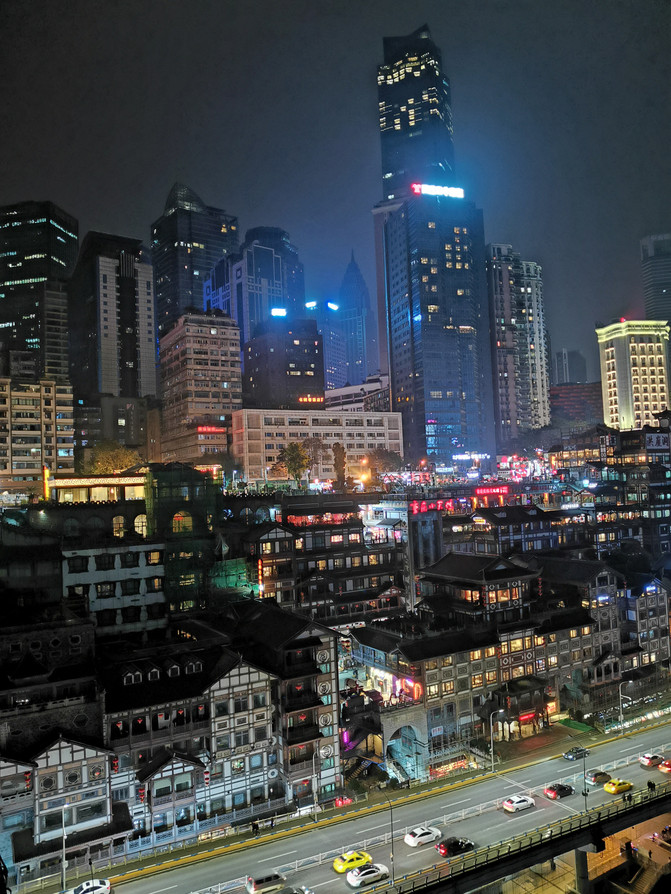
Step onto the nearby Qiansimen Bridge and look back at Hongyadong. The Hongyadong stilted house, built along the mountain and along the river, belongs to the style of railing architecture. From a distance, the building structure is simple, the bay is flexible, and the shape is indefinite. A group of stilted buildings that follow the slope form a linear road space, with the lower part of the stilted buildings suspended as a void and the upper part enclosed as a solid. The dimly lit Hongya Cave is quiet, surrounded by nearby high-rise buildings, giving it a dreamy feeling of traveling back to ancient times.

On the night of November 27th, I came to Hongyadong again. Because it's not too late yet, I saw the dazzling lights and bustling streets of Hongyadong.



The Hongyadong Folk Customs Area, located in Yuzhong District, Chongqing, is bordered by Jialing River to the north and Cangbai Road to the south. Walking down the escalator into the Hongyadong block, you can see a roughly four story street market: the top floor is the "City Balcony Exotic Style Street" on Cangbai Road, and the lower three floors are the "Zhiyan River Dynamic Bar Street", "Tiancheng Lane Bayu Style Street", and the "Hongyadong Feast Street Food Street" on the ancient stone slab road next to the rock cliff of Chongqing's old city wall. The three story buildings in each floor are mostly suspended buildings.

Standing on the banks of the Jialing River and the Qiansimen Bridge, looking at Hongya Cave, the brightly lit Hongya Cave exudes a sense of heavenly and earthly fireworks and dreamlike atmosphere.








On the evening of November 28th, I returned to Chongqing from Dazu and took a cruise to Chaotianmen Port to enjoy the night view of the Jialing River and the Yangtze River in Chongqing.


Entering the Jialing River, crossing the Qiansimen Bridge, and looking out at the Hongya Cave from the Jialing River, there is a unique scenery with dazzling lights.

On the morning of November 29, 2020, cross the Yangtze River to Mount Huangshan Mountain, located in the south bank of Chongqing. When I reached the deep valley of Mount Huangshan Mountain, I saw the logo of Chongqing Anti Japanese War Relics Museum. This is where I want to come.

Mount Huangshan Mountain is located at the easternmost end of the Nanshan Forest Zone on the south bank of Chongqing, and the number of ancient and famous trees ranks first in Chongqing. At the beginning of the 20th century, Huang Yunjie, the comprador of Chongqing Baili Foreign Firm, bought this mountain forest as private property, and purchased and built a villa named Huangjia Garden, also known as Mount Huangshan Mountain. In October 1937, the National Government moved its capital to Chongqing, and Chiang Kai shek's attendants bought Mount Huangshan to build official residences for Chiang Kai shek and others. Mount Huangshan became the military, political and diplomatic center of the National Government during the Anti Japanese War. Mount Huangshan official residence was Chiang Kai shek's favorite residence and longest residence in the wartime capital Chongqing. It was a permanent residence for air defense, summer vacation and office work. There are 15 existing Anti Japanese War sites in Mount Huangshan, which are in the east and west sections, and distributed in horseshoe shape along the mountain. They are all official residence style buildings built in the Republic of China, simple and elegant, with typical eclectic style of Chinese and Western styles and rich mountain features.

Walk into Mount Huangshan Mountain and meander along the mountain path halfway up the mountain. Look around Mount Huangshan Mountain, surrounded by pines and cypresses, strange peaks and valleys. The scenery is excellent.


Following the directional signs of the scenic area, I walked up the mountain on the left side and headed towards Yunxiu Tower and Caoting.


Arriving at the Grass Pavilion halfway up the mountain, this small building was originally a guesthouse for the Military Commission of the Nationalist Government. Zhang Zhizhong and Chiang Ching kuo had both lived there before, and later became the former residence of the US presidential envoy Marshall.
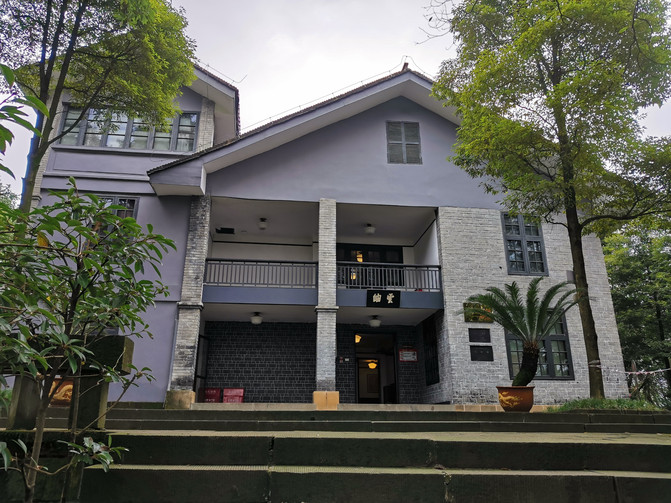
After leaving the thatched pavilion, we turned back and continued to climb the mountain. There was a villa on the top of the mountain. When we saw the sign, it was Yunxiu Tower, the famous official residence of Chiang Kai shek in Mount Huangshan. From December 1938 to 1946, Chiang Kai shek lived here for most of his time in Chongqing.
The Yunxiu Tower, which is located on the top of the highest peak of Mount Huangshan Mountain, stands out in the dense forest. The surrounding cliffs are steep. Only a narrow stone ladder, which can not be paralleled by two people, can connect with each other. The pines cover the sky, the cypresses are rich, and the forests are rustling. It is quite symbolic that the government in the old era respectfully called the boss and the highest boss "the highest peak" and "the highest peak".

Entering the small building, there is a map hanging on the wall of the conference room on the first floor, which reminds people of the military, political, and diplomatic events that this room witnessed and experienced during the Anti Japanese War.


Arriving at Chiang Kai shek's office on the second floor, there hung on the wall the inscription of Chiang Kai shek's "perseverance and excellence", which of course was no longer an authentic work.

There are also some historical materials from the Anti Japanese War displayed in Yunxiu Building.

Leave Yunxiu Tower and head to Songting. Halfway there, I saw a small path leading to the air raid shelter, so I went there to take a look. It is said that this air raid shelter was personally dug by Chiang Kai shek to avoid Japanese aircraft bombing. There are two exits inside the shelter, one leading to Yunxiu Tower and the other to Caoting.
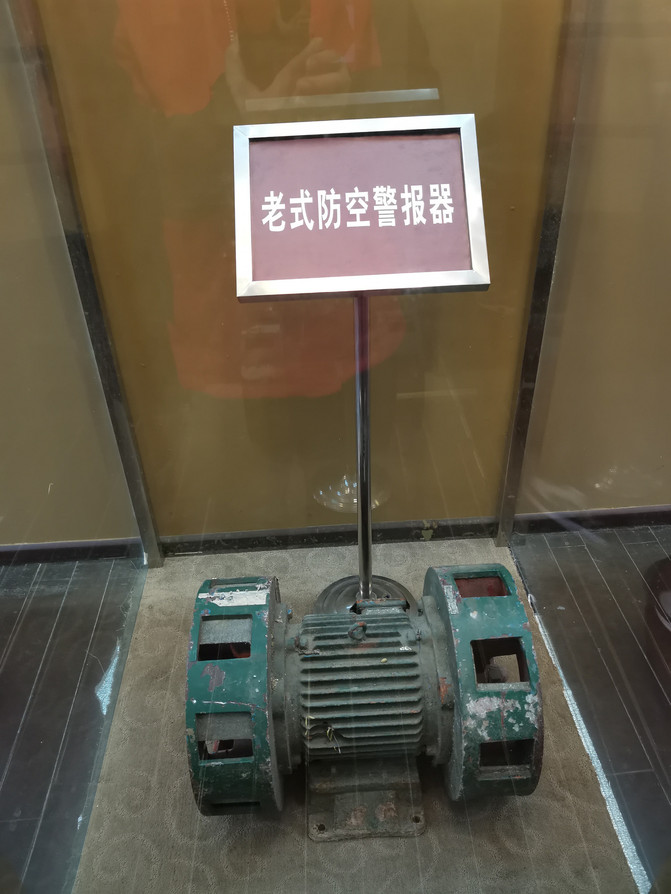
During the Anti Japanese War, the Japanese army launched multiple air raids on Chongqing, and Chiang Kai shek also suffered greatly from it. On August 30, 1941, the Japanese army launched a surprise attack on Chongqing using 200 bombers in 10 batches. At that time, Chiang Kai shek was holding a military conference at the Mount Huangshan official residence. The Japanese plane came quietly, dropped a batch of bombs, hit the corner of the "Yunxiu Tower", killing two guards and injuring four. Chiang Kai shek and the attendees were in a hurry, stepping on bloodstains and hiding in the air raid shelter, which saved them from danger. The iron door of the air raid shelter is tightly closed and cannot be observed inside. Standing in the forest clearing in front of the air raid shelter, wandering around, there are often civilian planes flying in the air, which gives me a sense of immediacy when Japanese bombers attacked.

Arriving at Songtang, this villa is also known as the "Soong Mei ling Villa".


The name Songting was also personally inscribed by Chiang Kai shek.




There are cinnamon trees planted in front of the pine hall, and pine forests behind the building, creating a beautiful scenery.

Not far from the Pine Hall is Kong Garden, the villa of Kong Lingwei, the second daughter of Kong Xiangxi, and the largest villa in Mount Huangshan.

The small bungalow in front of us was the second conference room of that time, and the small house next to it was the attendant's room, which was also the residence of Chiang Kai shek's guards.


Arriving at Songlai Pavilion, this villa is said to have been built by Chiang Kai shek for Soong Ching ling, hence the name Soong Ching ling Villa. Standing on the balcony on the second floor of the villa, it is said that you can watch the rising sun in the morning, the sunset in the evening, and the shallow valley scenery of Mount Huangshan Mountain.



Not far from Songlai Pavilion is Yunfeng Tower, which was the residence of He Yingqin at that time. The semi-circular platform below Yunfeng Tower is said to have been the place where He Yingqin practiced Tai Chi in the morning.

Returning to the fork in the road that once led to Caoting and Yunxiu Tower, I found a dirt road leading to the mountain peak above Caoting. Upon closer inspection, there were inconspicuous road signs pointing to Wangjiang Pavilion on the ground.


Winding up the mountain along the way, finally turning the peak, I suddenly saw a clear view in front of me. A pavilion stood on the top of the cliff, and I arrived at the Wangjiang Pavilion.

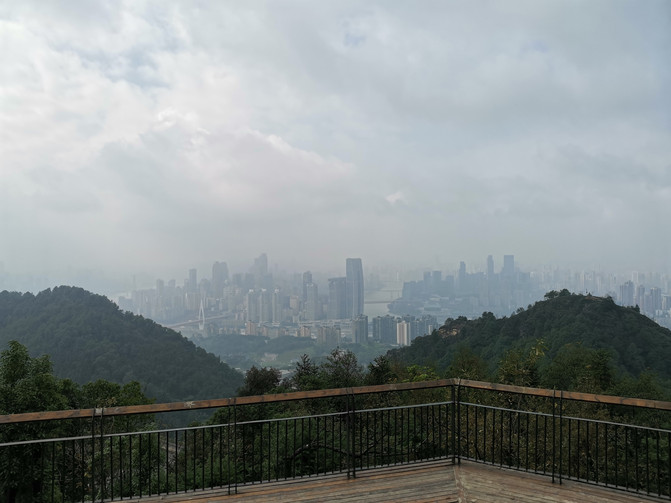
Arriving at Wangjiang Pavilion, although there is some haze, the scenery of Chongqing Mountain City is still clearly visible in the distance.




It is said that when Chongqing was bombed by the Japanese army, Chiang Kai shek stood with Chen Naide and others at Wangjiang Pavilion, gazing down at the thick smoke and flames of the Chongqing urban area on the Yuzhong Peninsula, and pondered over countermeasures. Chen Naide's Flying Tigers were born as a result. Standing at the Wangjiang Pavilion now, tall buildings stand tall on both sides of the Jialing River and the Yangtze River, and the mountainous city of Chongqing once presented a bustling urban vitality and atmosphere.
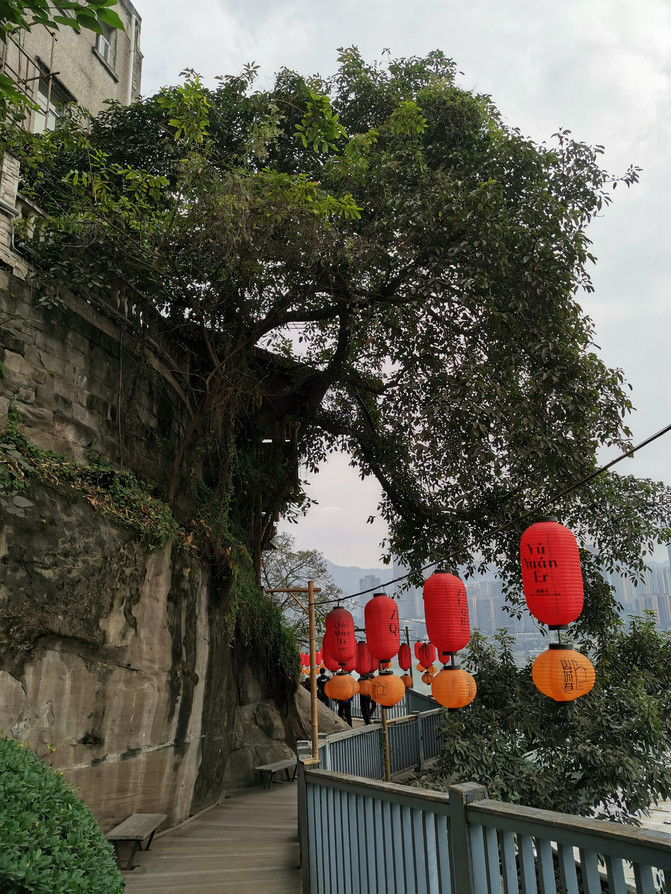
Go down the mountain, cross the Yangtze River, and return to Yuzhong District to visit the mountain city trail.
Entering from the gate of Zhongxing Road Mountain City Trail, heading uphill to the left is Mountain City Lane. Shancheng Lane was originally named Tiandeng Lane. In 1900, French missionaries erected poles and lit lamps on the slope of this lane to provide illumination for passersby. From a distance at night, the streetlights in this area looked like stars, and because the terrain was high, it felt like it was in the sky, hence the name Tiandeng Lane. In 1972, it was renamed Shancheng Lane. Walk uphill along the stone steps, walking in the mountain city alley. This alley winds along a cliff, with the Yangtze River on the left and houses on the right. Most of the houses are old buildings and residential buildings, but now they are mostly converted into small shops, and they are also shops in artistic style.

The stone gate in front of us is called the "Changle Yongkang" Stone Dynasty Gate, which is said to have a history of over a hundred years. The four characters "Changle Yongkang" are engraved on the lintel of Shichao, which have become somewhat weathered and blurred.


Continuing forward, a building with a hint of Shanghai Shikumen architectural style appeared, called "Houlu". It is said that it was originally the official residence of a commander named Lan Wenbin under the jurisdiction of Sichuan warlord Liu Xiang during the Anti Japanese War, and now it has become a tourist shop.


Continuing forward, a ruin appeared beside the alley, which is the site of the Renai Church built by French missionaries back then. In 1902, French missionaries built the Ren'ai Church Hospital, church, monastery, and priest's residence here, and it is said that there are still some remaining buildings today. But I looked there and found that it had been completely demolished, indicating that it was ready for restoration.

Following Shancheng Lane to the fork in the road, continuing up is Shancheng Lane that no longer faces the river. On the left side facing the cliff and facing the river is a suspended plank road, which is the true Shancheng Trail.

Walk along this sightseeing boardwalk suspended on the cliff, and admire the scenery of the Yangtze River and its south bank on the left side.

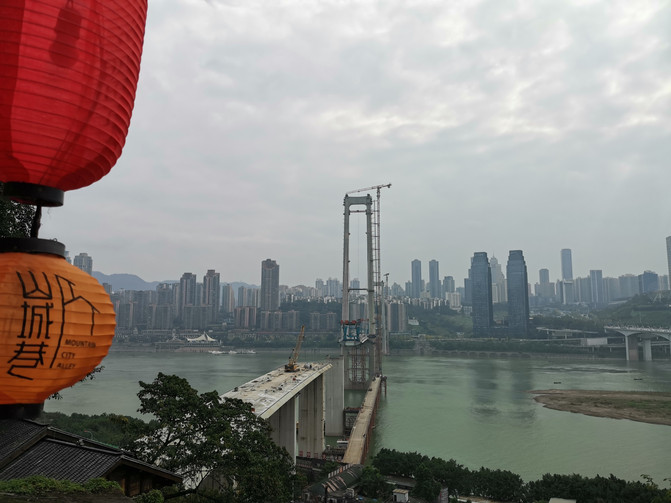
Nearby is the Chongqing Yangtze River Bridge, and in the distance is the Caiyuanba Yangtze River Bridge. A new Yangtze River Bridge is currently under construction on the left side of the Chongqing Yangtze River Bridge.

The sandbar in the middle of the Yangtze River under the Chongqing Yangtze River Bridge is called Shanhu Dam, and an airport was built during the Anti Japanese War.

On the right side of the boardwalk is a cliff, and upon closer inspection, there is a stone city wall above it, indicating that it is the ancient city wall of Chongqing.



The mountain city trail I am walking is the third trail in Chongqing. It is said to be the longest and steepest historical ancient path in Chongqing, climbing up along the ancient city wall and mountain terrain. After renovation, the trail has become a fitness and scenic spot for Chongqing citizens.

After walking on the boardwalk, the next step is the cliff facing stone steps, gradually getting away from the river.


There is a nameplate under the ancient cliff city wall introducing that this section of the city wall is the Jintangmen section. The ancient city of Chongqing surrounds the Yuzhong Peninsula with nearly eight kilometers of city walls and seventeen gates, of which nine are open and eight are closed.

Continuing forward for a while, the trail begins to descend and is about to reach its endpoint. It is said that the path ahead leads to the ancient city of Chongqing, known as the 'Tongyuan Gate'. I thought it was like the Golden Soup Gate in front of me, without any traces of a city gate, so I didn't move forward and turned back. Later, I found out that Tongyuanmen is a visible ancient city gate site in Chongqing, and the city gate is still there. Moreover, Tongyuanmen is the only land gate among all the city gates in Chongqing, worth a visit, but I actually missed it.
Previous Article:4-Day Free Tour in Chongqing
Next Article:Explore Wulong | A hidden landscape 4.5 hours away from the main urban area of Chengdu!
